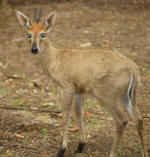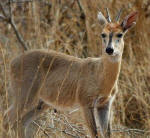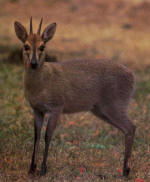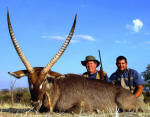Duiker
Physical Characteristics Duikers are small antelopes that inhabit forest or dense bushland. They are a good example of
how an animal can be very successful in finding and filling a certain ecological niche. They are the most widespread of all
the forest antelopes and are represented in East Africa by 13 of their 17 species. The smallest of the duikers is the blue
duiker, which in East Africa is found in Uganda, western Kenya and parts of Tanzania. The largest is the yellow-backed duiker,
which ranges across the whole of the African tropical forest block. Populations of the yellow-backed duiker are also found on
Mt. Elgon and on the Mau in Kenya. This duiker reaches up to 35 inches in height and 175 pounds in weight. It has distinctive,
long whitish-yellow to orange hair that stands erect on the back. A striking peculiarity of the duikers in the genus Cephalophus
is that they all have the same distinctive body type, although the different species vary in size. Duikers have low-slung bodies
on slender legs, wedge-shaped heads topped by a crest of long hair, and relatively large eyes. With their heads held close to
the ground, duikers can move easily through the dense vegetation of forests and bushlands. They regularly run through these
areas and when disturbed, plunge into thick cover to hide. This trait is the source of the name "duiker," which in Dutch means "diver."
Duikers are divided into two groups: forest duikers and bush duikers. The bush duiker is more slender, with larger ears, than
the forest duiker. Environment and habitat can influence the overall body shape and coloration of animals: Thus, the duiker
living in open habitat is longer-legged, less hunched-backed and lighter in color (tawny or gray) than the species that
inhabits the dense, dark forests.
The bush duiker is represented by only one species known as the common or Grimm's duiker. This is the most widely distributed
duiker in East Africa and is found in a large range of habitats at different elevations, but never in deep forest. Unlike the
forest species, the bush duiker with its long legs is able to run fast for some distance. All duikers freeze and crouch to
escape detection. The duikers have dark, slick glossy coats but their tails have white hair that contrasts with the dark body.
The tail is constantly in motion with each movement looking like a tiny torch being switched on and off in the forest gloom.
Even though the bush females are larger than the males, they usually do not have horns. Male and female forest duikers are
about the same size and both have horns. Duiker horns are small and spikelike, lying so flat against the head that they are
not too useful in fighting.
Habitat The little blue duiker and yellow-backed duiker species live in montane, riverine and rain forests. The bush
duiker lives mostly in moist savannas; it avoids rain forests.
Behavior Males do fight, especially when territory is invaded. Duikers inhabit fairly small territories marked with
the secretions from the preorbital gland below each eye. Even though a pair will live together in the territory, they will
spend most of the time apart. Courtship involves prolonged and noisy chases about the territory before mating, after which
a single young is born. A calf can run within hours of birth, but usually lies hidden for long periods of time between
sucklings. It grows rapidly and is adult-sized at 6 to 7 months. The young utter a loud bleat when in danger, quickly
signaling adults in the area.
Diet Duikers have interesting and varied feeding habits. The large mouth permits them to feed on sizable fruits,
mushrooms and other bulky items. They eat berries and fruit that have fallen naturally, as well as those dropped by monkeys,
but most of their diet consists of foliage from bushes and trees. On occasion duikers may eat insects, lizards, birds and rodents.
Predators and ThreatsDuikers have lived as long as 12 years in captivity, when bred as food sources of cheap meat
in West Africa. They are popular as pets, even though males tend to become dangerous as they mature. Among their natural
enemies are the lion, leopard, cheetah, serval, hunting dog, hyena, jackal, baboon, python, crocodile and eagles. Large owls,
monitor lizards and genets prey on the young. Despite so many predators, the duikers have successfully managed to maintain their numbers.
Did You Know? Duiker pairs devote a great deal of time to grooming one another's heads, which apparently aids in
bonding pairs; it may also help individuals recognize their own species and discourage interbreeding with others. Hunters
imitate the bleat of duikers and set snares on their runs. The animals are hunted for their meat, skins and horns, which are
popular in some areas as charms against evil spirits. Bush duikers may be hunted in reprisal for raiding crops.
Price - $390.00
|

Duiker

Duiker

Duiker

Duiker
|

